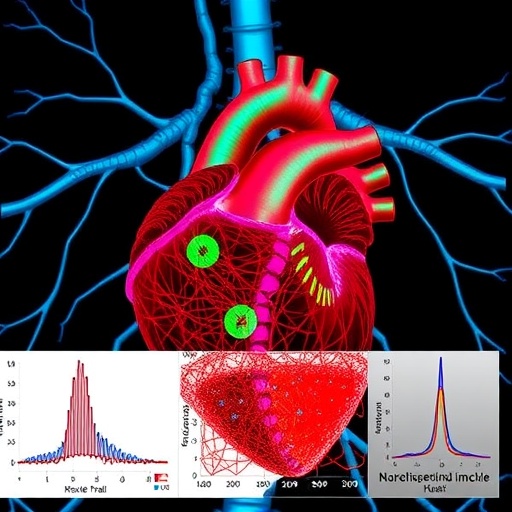In a groundbreaking study published in Cell Death Discovery, researchers have uncovered a pivotal mechanism by which cardiomyocytes—the muscle cells of the heart—reactivate a developmental signaling pathway following extracellular matrix (ECM) remodeling. This reactivation of the YAP1 protein emerges as a critical driver in the maturation of sarcomeres and the enhancement of contractile force, shedding light on the complex regenerative and adaptive capacities of the heart. The discovery not only deepens our understanding of cardiomyocyte biology but also holds significant implications for future cardiac therapy development.
The extracellular matrix, a dynamic network of proteins and polysaccharides, provides structural support to tissues and actively influences cell behavior. In the context of cardiac tissue, ECM remodeling is a hallmark of both normal physiological adaptation and pathological conditions such as myocardial infarction or heart failure. However, the molecular consequences of ECM changes on resident heart cells have remained incompletely understood. This new work highlights ECM remodeling as a triggering event that prompts cardiomyocytes to revert to a more developmentally plastic state through YAP1 signaling activation.
YAP1, or Yes-associated protein 1, functions as a transcriptional co-activator within the Hippo signaling pathway—a critical regulator of organ size control, cell proliferation, and apoptosis. During heart development, YAP1 activity is prominent in cardiomyocytes, driving their growth and differentiation. Postnatally, however, YAP1 is downregulated as cells exit the cell cycle and mature. The study by Vinarsky, Pagliari, Aldabash, and colleagues reveals that ECM remodeling can prompt a revival of YAP1 activity even in mature cardiomyocytes, creating a cellular environment conducive to enhanced contractile function.
Technically, the research team employed advanced molecular and imaging techniques to interrogate cardiomyocyte behavior within remodeled ECM environments. Through a combination of genetically engineered mouse models and in vitro cultures mimicking various ECM compositions, they demonstrated that remodeling leads to increased nuclear localization of YAP1—a hallmark of its activation. This nuclear translocation initiates transcription programs promoting sarcomere assembly, a key structural feature essential for the contractile mechanics of heart muscle cells.
Sarcomeres, the fundamental contractile units within muscle cells, are composed of highly organized arrays of actin and myosin filaments. Their proper maturation is crucial for effective force generation during heartbeats. The study shows that upon YAP1 reactivation, cardiomyocytes exhibit improved sarcomere organization with increased expression of structural proteins, including α-actinin and cardiac troponins. These changes corresponded with measurable enhancements in contractile force generation, assessed using sensitive biomechanical assays.
Interestingly, the findings suggest that YAP1 reactivation does not merely serve as a compensatory response to injury but actively drives functional improvements in cardiac tissue. This challenges previous paradigms that viewed post-injury cardiac remodeling primarily as a maladaptive process with limited regenerative capacity. The ability to harness this intrinsic mechanism may pave the way for novel therapeutic strategies aimed at restoring heart function after damage.
This study also underscores the importance of ECM composition and mechanical cues in regulating cardiomyocyte fate and function. Changes in ECM stiffness and molecular composition during development, aging, or disease can thus serve as signals that dynamically modulate intracellular pathways like Hippo-YAP. By decoding this extracellular-intracellular communication axis, researchers can better understand how microenvironmental changes influence heart muscle physiology.
Moreover, the authors provide evidence that YAP1 activation is tightly regulated to prevent uncontrolled cell proliferation, a key consideration to avoid oncogenic transformation. They observed that YAP1-driven sarcomere maturation and force development occurred without re-entry into the cell cycle, indicating a discrete, non-proliferative role of YAP1 in cardiac cellular remodeling. This fine-tuning presents opportunities for targeted interventions that selectively boost contractile properties without triggering adverse effects.
The translational potential of these findings is vast. Heart disease remains the leading global cause of mortality, with limited capacity for myocardial regeneration contributing to poor outcomes after cardiac injury. By discovering that ECM remodeling can reactivate a developmental growth program via YAP1, this research suggests that modulating ECM or directly targeting YAP1 pathways could enhance heart repair processes, supporting functional recovery.
Future studies will be needed to dissect the detailed molecular mechanisms downstream of YAP1 and how its activity integrates with other signaling networks during cardiac remodeling. Additionally, exploring how these pathways operate in human heart tissues and disease contexts will be critical to validate their therapeutic relevance. The development of pharmacological agents or biomaterials designed to modulate ECM composition and mechanical properties represents a promising avenue stemming from this knowledge.
The integration of single-cell transcriptomics and high-resolution imaging methodologies played a crucial role in unraveling the cellular adaptations during ECM remodeling. These cutting-edge tools allowed the mapping of YAP1 activation patterns and sarcomere development with unprecedented spatial and temporal resolution, highlighting the power of interdisciplinary approaches in modern biomedical research.
Collectively, this study redefines the biological significance of ECM remodeling not just as a structural remodeling event but as a potent signaling cue that reawakens cardiomyocyte plasticity. Such insights deepen the conceptual framework underpinning cardiac development, disease, and regeneration, and open new frontiers for innovative treatments aimed at mitigating heart failure and promoting myocardial regeneration.
In conclusion, the discovery of YAP1 reactivation in cardiomyocytes following extracellular matrix remodeling establishes a crucial link between the heart’s microenvironment and its intrinsic capacity to optimize contractile function. This advancement offers hope for engineering regenerative therapies that can restore cardiac mechanics, improve patient outcomes, and reduce the burden of cardiovascular disease worldwide. As research in this field accelerates, the potential to harness developmental pathways for adult heart repair heralds a transformative era in cardiovascular medicine.
Subject of Research: Reactivation of YAP1 signaling in cardiomyocytes induced by extracellular matrix remodeling and its role in sarcomere maturation and contractile force enhancement.
Article Title: YAP1 reactivation in cardiomyocytes following ECM remodelling contributes to the development of contractile force and sarcomere maturation.
Article References:
Vinarsky, V., Pagliari, S., Aldabash, B. et al. YAP1 reactivation in cardiomyocytes following ECM remodelling contributes to the development of contractile force and sarcomere maturation. Cell Death Discov. 11, 518 (2025). https://doi.org/10.1038/s41420-025-02793-2
Image Credits: AI Generated
DOI: 10 November 2025




